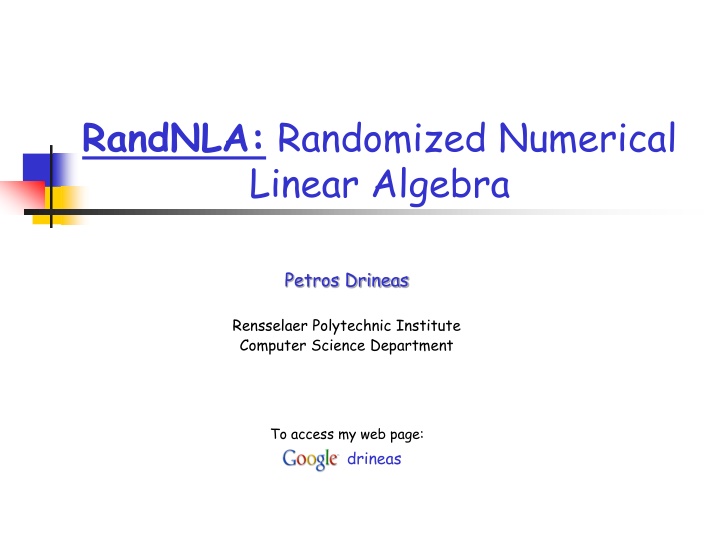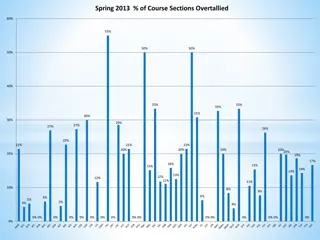
Randomized Numerical Linear Algebra by Petros Drineas - Sketch Algorithms for Matrix Sampling
Explore the world of randomized numerical linear algebra with Petros Drineas from Rensselaer Polytechnic Institute. Learn about sketch algorithms for matrix sampling, including row and column sampling techniques such as length-squared sampling and leverage scores. Discover how these sampling methods lead to efficient low-rank matrix approximations and Singular Value Decomposition (SVD). Dive into the applications of these techniques in various factorizations and approximation methods.
Download Presentation

Please find below an Image/Link to download the presentation.
The content on the website is provided AS IS for your information and personal use only. It may not be sold, licensed, or shared on other websites without obtaining consent from the author. If you encounter any issues during the download, it is possible that the publisher has removed the file from their server.
You are allowed to download the files provided on this website for personal or commercial use, subject to the condition that they are used lawfully. All files are the property of their respective owners.
The content on the website is provided AS IS for your information and personal use only. It may not be sold, licensed, or shared on other websites without obtaining consent from the author.
E N D
Presentation Transcript
RandNLA: Randomized Numerical Linear Algebra Petros Drineas Rensselaer Polytechnic Institute Computer Science Department To access my web page: drineas
RandNLA:sketch a matrix by row/column sampling Sampling algorithm (rows) Input: m-by-n matrix A, sampling parameter r Output: r-by-n matrix R, consisting of r rows of A Let pi for i=1 m be sampling probabilities summing up to 1; In r i.i.d. trials (with replacement) pick r rows of A; (In each trial the i-th row of A is picked with probability pi.) Let R be the matrix consisting of the rows; (We rescale the rows of A prior to including them in R by 1/(rpi)1/2.)
RandNLA:sketch a matrix by row/column sampling Sampling algorithm (rows) Input: m-by-n matrix A, sampling parameter r Output: r-by-n matrix R, consisting of r rows of A Let pi for i=1 m be sampling probabilities summing up to 1; In r i.i.d. trials (with replacement) pick r rows of A; (In each trial the i-th row of A is picked with probability pi.) Let R be the matrix consisting of the rows; (We rescale the rows of A prior to including them in R by 1/(rpi)1/2.) Column sampling is equivalent to row sampling, simply by working with AT instead of A.
The pis: length-squared sampling Length-squared sampling: sample rows with probability proportional to the square of their Euclidean norms, i.e., Notation: A(i) : the i-th row of A ||A||F : the Frobenius norm of A
The pis: length-squared sampling Length-squared sampling: sample rows with probability proportional to the square of their Euclidean norms, i.e., Notation: A(i) : the i-th row of A ||A||F : the Frobenius norm of A Leads to additive-error approximations for low-rank matrix approximations and the Singular Value Decomposition (SVD), the CUR and CX factorizations, the Nystrom method, etc. (Drineas, Kannan, Mahoney SICOMP 2006a, SICOMP 2006b, SICOMP 2006c, Drineas & Mahoney JMLR 2005, etc.)
The pis: leverage scores Leverage score sampling: sample rows with probability proportional to the square of the Euclidean norms of the rows of the top k left singular vectors of A. Notation: Uk: the m-by-k matrix containing the top k left singular vectors of A (Uk)(i) : the i-th row of Uk k=||Uk||F: the Frobenius norm of Uk
The pis: leverage scores Leverage score sampling: sample rows with probability proportional to the square of the Euclidean norms of the rows of the top k left singular vectors of A. Notation: Uk: the m-by-k matrix containing the top k left singular vectors of A (Uk)(i) : the i-th row of Uk k=||Uk||F: the Frobenius norm of Uk and
The pis: leverage scores Leverage score sampling: sample rows with probability proportional to the square of the Euclidean norms of the rows of the top k left singular vectors of A. Notation: Uk: the m-by-k matrix containing the top k left singular vectors of A (Uk)(i) : the i-th row of Uk k=||Uk||F: the Frobenius norm of Uk Leads to relative-error approximations for: low-rank matrix approximations and the Singular Value Decomposition (SVD), the CUR and CX factorizations, Over- and under- constrained least-squares problems Solving systems of linear equations with Laplacian input matrices
The pis: leverage scores Leverage score sampling: sample rows with probability proportional to the square of the Euclidean norms of the rows of the top k left singular vectors of A. Notation: Uk: the m-by-k matrix containing the top k left singular vectors of A (Uk)(i) : the i-th row of Uk k=||Uk||F: the Frobenius norm of Uk Column sampling is equivalent to row sampling by focusing on AT and looking at its top k left singular vectors (Which, of course, are the top k right singular vectors of A, often denoted as Vk , an n-by-k matrix.)
Leverage scores: tall & thin matrices Let A be a (full rank) n-by-d matrix with n>>d whose SVD is:
Leverage scores: tall & thin matrices Let A be a (full rank) n-by-d matrix with n>>d whose SVD is: i-th row of Uk (Row) Leverage scores: (set k to d) The (row) leverage scores can now be used to sample rows from A to create a sketch.
Leverage scores: short & fat matrices Let A be a (full rank) d-by-n matrix with n>>d:
Leverage scores: short & fat matrices Let A be a (full rank) d-by-n matrix with n>>d: j-th column of VT (or j-th row of V) (Column) Leverage scores: (set k to d) The (column) leverage scores can now be used to sample rows from A to create a sketch.
Leverage scores: general case Let A be an m-by-n matrix A and let Ak be its best rank-k approximation (as computed by the SVD) :
Leverage scores: general case Let A be an m-by-n matrix A and let Ak be its best rank-k approximation (as computed by the SVD) : i-th row of Uk j-th column of VT (Column) Leverage scores: (Row) Leverage scores: The (row/column) leverage scores can now be used to sample rows/columns from A.
Other ways to create matrix sketches Sampling based Volume sampling: see Amit Deshpande s talk tomorrow. Random projections Pre or post-multiply by Gaussian random matrices, random sign matrices, etc. (Faster) Pre or post-multiply by the sub-sampled Hadamard Transform. (Sparsity) Pre- or post-multiply by ultra-sparse matrices (Michael Mahoney s talk). Deterministic/streaming sketches Select columns/rows deterministically (some ideas in Nikhil Srivastava s talk on graph sparsification). From item frequencies to matrix sketching (see Edo Liberty s talk). Element-wise sampling Sample elements with probabilities that depend on the absolute value (squared or not) of the matrix entries. Sample elements with respect to an element-wise notion of leverage scores! Beyond matrices: tensors (Ravi Kannan s talk) 16
Applications of leverage scores Over (or under)-constrained Least Squares problems Feature selection and the CX factorization Solving systems of linear equations with Laplacian input matrices Element-wise sampling 17
Applications of leverage scores Over (or under)-constrained Least Squares problems Feature selection and the CX factorization Solving systems of linear equations with Laplacian input matrices Element-wise sampling BUT FIRST THINGS FIRST: Why do they work? How fast can we compute them? 18
Why do they work? ALL proofs that use leverage score sampling use an argument of the following form: U is an orthogonal matrix: UTU = Id Sample/rescale r rows of U w.r.t. the leverage scores (use the sampling algorithm of slide 2):
Why do they work? ALL proofs that use leverage score sampling use an argument of the following form: U is an orthogonal matrix: UTU = Id Sample/rescale r rows of U w.r.t. the leverage scores (use the sampling algorithm of slide 2):
Why do they work? ALL proofs that use leverage score sampling use an argument of the following form: is a full-rank matrix! U is an orthogonal matrix: UTU = Id Then, with probability at least 1- : It follows that, for all i:
Why do they work? Recall: with probability at least 1- : It follows that, for all i: This implies that has full rank. The result follows from randomized matrix multiplication algorithms and a matrix-Bernstein bound. (see the tutorials by Drineas, Mahoney, and Tropp at the Simons Big Data Bootcamp, Sep 2-5, 2013) These bounds allow us to manipulate the pseudo-inverse of and products of with other matrices.
Computing leverage scores Trivial: via the Singular Value Decomposition O(nd2) time for n-by-d matrices with n>d. O(min{m2n,mn2}) time for general m-by-n matrices. Non-trivial: relative error (1+ ) approximations for all leverage scores. Tall & thin matrices (short & fat are similar): Approximating leverage scores: 1. Pre-multiply A by say the subsampled Randomized Hadamard Transform matrix (an s-by-n matrix P). 2. Compute the QR decomposition PA = QR. 3. Estimate the lengths of the rows of AR-1 (another random projection is used for speed)
Computing leverage scores Trivial: via the Singular Value Decomposition O(nd2) time for n-by-d matrices with n>d. O(min{m2n,mn2}) time for general m-by-n matrices. Non-trivial: relative error (1+ ) approximations for all leverage scores. Tall & thin matrices (short & fat are similar): Running time: It suffices to set s = O(d -1 polylog(n/ )). Overall running time is O(nd -1 polylog(n/ )).
Computing leverage scores Trivial: via the Singular Value Decomposition O(nd2) time for n-by-d matrices with n>d. O(min{m2n,mn2}) time for general m-by-n matrices. Non-trivial: relative error (1+ ) approximations for all leverage scores. m-by-n matrices: Caution: A direct formulation of the problem is ill-posed. (The k and (k+1)-st singular values could be very close estimating the corresponding singular vectors could result in a swap .) A robust objective is to estimate the leverage scores of some rank k matrix X that is close to the best rank k approximation to A. (see Drineas et al. (2012) ICML and JMLR for details)
Computing leverage scores Trivial: via the Singular Value Decomposition O(nd2) time for n-by-d matrices with n>d. O(min{m2n,mn2}) time for general m-by-n matrices. Non-trivial: relative error (1+ ) approximations for all leverage scores. m-by-n matrices: Algorithm: Approximate the top k left (or right) singular vectors of A. Use the approximations to estimate the leverage scores. Overall running time is r = O(ndk -1 polylog(n/ )).
Applications of leverage scores Over (or under)-constrained Least Squares problems Feature selection and the CX factorization Solving systems of linear equations with Laplacian input matrices Element-wise sampling 27
Least-squares problems We are interested in over-constrained least-squares problems, n >> d. (Under-constrained problems: see Tygert 2009 and Drineas et al. (2012) JMLR) Typically, there is no xopt such that Axopt = b. Want to find the best xopt such that Axopt b.
Exact solution to L2 regression Cholesky Decomposition: If A is full rank and well-conditioned, decompose ATA = RTR, where R is upper triangular, and solve the normal equations: RTRx = ATb. Projection of b on the subspace spanned by the columns of A QR Decomposition: Slower but numerically stable, esp. if A is rank-deficient. Write A = QR, and solve Rx = QTb. Pseudoinverse of A Singular Value Decomposition: Most expensive, but best if A is very ill-conditioned. Write A = U VT, in which case: xopt = A+b = V -1UTb. Complexity is O(nd2) , but constant factors differ.
Algorithm: Sampling for L2 regression (Drineas, Mahoney, Muthukrishnan SODA 2006, Drineas, Mahoney, Muthukrishnan, & Sarlos NumMath2011) Algorithm 1. Compute the row-leverage scores of A (pi, i=1 n) 2. In r i.i.d. trials pick r rows of A and the corresponding elements of b with respect to the pi. (Rescale sampled rows of A and sampled elements of b by (1/(rpi)1/2.) 3. Solve the induced problem.
Algorithm: Sampling for least squares Drineas, Mahoney, Muthukrishnan SODA 2006, Drineas, Mahoney, Muthukrishnan, & Sarlos NumMath2011 Algorithm 1. Compute the row-leverage scores of A (pi, i=1 n) 2. In r i.i.d. trials pick r rows of A and the corresponding elements of b with respect to the pi. (Rescale sampled rows of A and sampled elements of b by (1/(rpi)1/2.) 3. Solve the induced problem.
Theorem If the pi are the row leverage scores of A, then, with probability at least 0.8, The sampling complexity (the value of r) is (Hiding a loglog factor for simplicity; see Drineas et al. (2011) NumMath for a precise statement.)
Applications of leverage scores Over (or under)-constrained Least Squares problems Feature selection and the CX factorization Solving systems of linear equations with Laplacian input matrices Element-wise sampling 33
SVD decomposes a matrix as The SVD has strong optimality properties. Top k left singular vectors It is easy to see that X = UkTA. SVD has strong optimality properties. The columns of Uk are linear combinations of up to all columns of A.
The CX decomposition Mahoney & Drineas (2009) PNAS Carefully chosen X Goal: make (some norm) of A-CX small. c columns of A, with c being as close to k as possible Why? If A is a data matrix with rows corresponding to objects and columns to features, then selecting representative columns is equivalent to selecting representative features to capture the same structure as the top eigenvectors. We want c as close to k as possible!
CX decomposition c columns of A, with c being as close to k as possible Easy to prove that optimal X = C+A. (with respect to unitarily invariant norms; C+ is the Moore-Penrose pseudoinverse of C) Thus, the challenging part is to find good columns (features) of A to include in C. Also known as: the Column Subset Selection Problem (CSSP).
The algorithm Input: Output: m-by-n matrix A, target rank k 0 < < .5, the desired accuracy C, the matrix consisting of the selected columns Sampling algorithm Let pj be the column leverage scores of A, for j=1 n. In c i.i.d. trials pick columns of A, where in each trial the j-th column of A is picked with probability pj. Let C be the matrix consisting of the chosen columns. (c is a function of and k; see next slide)
Relative-error Frobenius norm bounds Given an m-by-n matrix A, let C be formed as described in the previous algorithm. Then, with probability at least 0.9, The sampling complexity (the value of c) is The running time of the algorithm is dominated by the computation of the (column) leverage scores.
Leverage scores: human genetics data Single Nucleotide Polymorphisms: the most common type of genetic variation in the genome across different individuals. They are known locations at the human genome where two alternate nucleotide bases (alleles) are observed (out of A, C, G, T). SNPs AG CT GT GG CT CC CC CC CC AG AG AG AG AG AA CT AA GG GG CC GG AG CG AC CC AA CC AA GG TT AG CT CG CG CG AT CT CT AG CT AG GG GT GA AG individuals GG TT TT GG TT CC CC CC CC GG AA AG AG AG AA CT AA GG GG CC GG AA GG AA CC AA CC AA GG TT AA TT GG GG GG TT TT CC GG TT GG GG TT GG AA GG TT TT GG TT CC CC CC CC GG AA AG AG AA AG CT AA GG GG CC AG AG CG AC CC AA CC AA GG TT AG CT CG CG CG AT CT CT AG CT AG GG GT GA AG GG TT TT GG TT CC CC CC CC GG AA AG AG AG AA CC GG AA CC CC AG GG CC AC CC AA CG AA GG TT AG CT CG CG CG AT CT CT AG CT AG GT GT GA AG GG TT TT GG TT CC CC CC CC GG AA GG GG GG AA CT AA GG GG CT GG AA CC AC CG AA CC AA GG TT GG CC CG CG CG AT CT CT AG CT AG GG TT GG AA GG TT TT GG TT CC CC CG CC AG AG AG AG AG AA CT AA GG GG CT GG AG CC CC CG AA CC AA GT TT AG CT CG CG CG AT CT CT AG CT AG GG TT GG AA GG TT TT GG TT CC CC CC CC GG AA AG AG AG AA TT AA GG GG CC AG AG CG AA CC AA CG AA GG TT AA TT GG GG GG TT TT CC GG TT GG GT TT GG AA Matrices including thousands of individuals and hundreds of thousands if SNPs are available.
Worldwide data South Altaians - - Spanish Japanese Nahua Mende Mbuti Mala Burunge Quechua Africa Europe E Asia America 274 individuals, 9 populations, ~10,000 SNPs Shriver et al. (2005) Hum Genom
PCA projection on the top three left singular vectors. Populations are clearly separated, BUT not altogether satisfactory: The principal components are linear combinations of all SNPs. Hard to interpret or genotype. Can we find actual SNPs that capture the information in the left singular vectors?
Leverage scores of the columns of the 274-by-10,000 SNP matrix Africa Europe Asia America * top 30 PCA-correlated SNPs PCA-scores SNPs by chromosomal order Paschou et al (2007; 2008) PLoS Genetics Paschou et al (2010) J Med Genet Drineas et al (2010) PLoS One
Selecting ancestry informative SNPs for individual assignment to four continents (Africa, Europe, Asia, America) Afr Eur Asi Ame Africa Europe Asia America * top 30 PCA-correlated SNPs PCA-scores SNPs by chromosomal order Paschou et al (2007; 2008) PLoS Genetics Paschou et al (2010) J Med Genet Drineas et al (2010) PLoS One
Applications of leverage scores Over (or under)-constrained Least Squares problems Feature selection and the CX factorization Solving systems of linear equations with Laplacian input matrices Element-wise sampling 44
Leverage scores & Laplacians Consider a weighted (positive weights only!) undirected graph G and let L be the Laplacian matrix of G. Assuming n vertices and m > n edges, L is an n-by-n matrix, defined as follows:
Leverage scores & Laplacians Consider a weighted (positive weights only!) undirected graph G and let L be the Laplacian matrix of G. Assuming n vertices and m > n edges, L is an n-by-n matrix, defined as follows: 0 0 Edge-incidence matrix (each row has two non-zero entries and corresponds to an edge; pick arbitrary orientation and use +1 and - 1 to denote the head and tail node of the edge). Diagonal matrix of edge weights Clearly, L = (BTW1/2)(W1/2B)= (BTW1/2)(BTW1/2)T.
Leverage scores & effective resistances (Spielman & Srivastava STOC 2008) Effective resistances: Let G denote an electrical network, in which each edge e corresponds to a resistor of resistance 1/we (the edge weight). The effective resistance Re between two vertices is equal to the potential difference induced between the two vertices when a unit of current is injected at one vertex and extracted at the other vertex.
Leverage scores & effective resistances (Spielman & Srivastava STOC 2008) Effective resistances: Let G denote an electrical network, in which each edge e corresponds to a resistor of resistance 1/we (the edge weight). The effective resistance Re between two vertices is equal to the potential difference induced between the two vertices when a unit of current is injected at one vertex and extracted at the other vertex. Formally, the effective resistances are the diagonal entries of the m-by-m matrix: R = BL+BT= B(BTWB)+BT
Leverage scores & effective resistances (Drineas & Mahoney ArXiv 2010) Lemma: The (row) leverage scores of the m-by-n matrix W1/2B are equal to the effective resistances of the edges of G. Edge-incidence matrix Diagonal matrix of edge weights
Leverage scores & effective resistances (Drineas & Mahoney ArXiv 2010) Lemma: The (row) leverage scores of the m-by-n matrix W1/2B are equal to the effective resistances of the edges of G. Edge-incidence matrix Diagonal matrix of edge weights GRAPH SPARSIFICATION Sample r edges to sparsify our graph G with respect to the row leverage scores of W1/2B (equivalently, the effective resistances of the edges of G). This process sparsifies the Laplacian L to construct a sparser Laplacian.

















